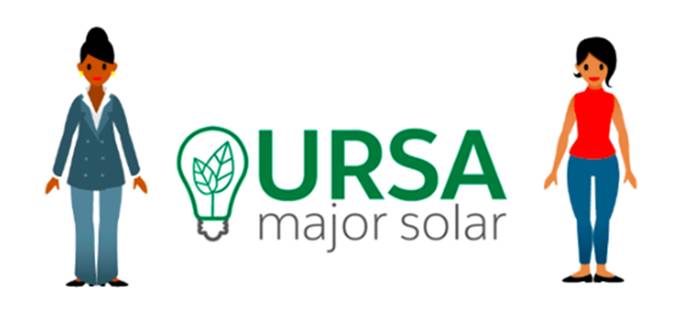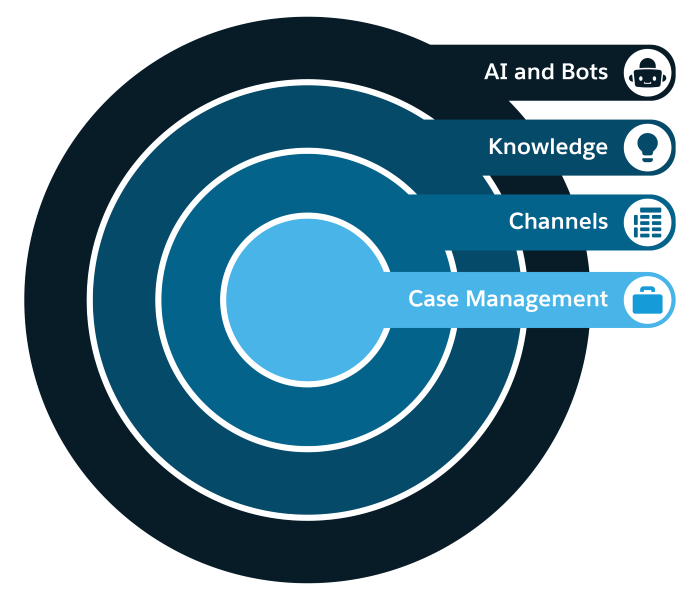Learn About Einstein Bots
Learning Objectives
After completing this unit, you’ll be able to:
- Explain what a chatbot is.
- Describe key benefits of chatbots.
- Begin the planning process to create Einstein Bots.
What's a Chatbot?
Like most companies, Ursa Major Solar is thinking ahead. After deploying Service Cloud, they’re getting higher customer service scores and supplying more solar energy components to homeowners and businesses than ever before. Sales are booming. Support is easier and faster. But Ursa Major Solar’s CEO, Sita Nagappan-Alvarez, knows that the competition never sleeps. She must plan for the future and understand the latest technologies to help her company succeed.
Sita’s been hearing a lot about chatbots. She feels like every time she reads an online business article or receives an email from a marketing company trying to sell her something, it’s all about chatbot technology. But what’s a chatbot? Why all the hype? Sita turns to her rock star admin, Maria Jimenez, for answers.

Maria’s been wondering about chatbots herself. From her own research online, she’s found some answers. A chatbot is an application that simulates human conversation, either aloud or via text message. Instead of having a conversation with a person, like a sales rep or support agent, a customer can have a conversation with a computer. Whether through typing or talking, a chatbot can connect with a customer. It can influence a customer relationship.
Maria also found a blog post that said 81% of decision makers say they're accelerating digital initiatives, including chatbots.
Chatbots for Digital Engagement
As Maria finds examples of chatbots online, she sees how they’re simply an additional channel for a company to engage with customers. Along with the now classic channels of phone, email, text message, and social media, chatbots present an option to connect with customers and build relationships.
But chatbots seem like a different kind of channel. From what Maria reads, they seem smarter than email or other communication options. When Maria thinks about her personal assistant at home, she’s amazed at the voice-enabled conversations she has with it. She can ask about the current weather in her hometown of Phoenix, or how much it costs to buy her cat’s favorite brand of catnip, and the answers always sound so intelligent. So...human.
Maria has also come across some not-so-smart chatbots. When typing questions, the answers she receives have nothing to do with her questions:
“How much is a plane ticket to Denver?”
“A Denver omelet has ham, cheese, peppers, and onions.”
“How much does a plane ticket to Denver cost?”
“Denver International Airport opened in 1995.”
Maria notices some chatbot responses are so off topic that she wonders if the bots are from another planet. So maybe bots aren’t so smart.
Chatbots and Artificial Intelligence
As Maria digs deeper into her research, she discovers that chatbots don’t equal AI. With all the chatbot hype she stumbled across, she thought all bots could nearly think and process words like people. But not all bots are hooked up to AI.
Instead, she learns that most human-like responses from chatbots are connected to a technology called natural language processing (NLP) or natural language understanding (NLU).
With NLU technology, we can train chatbots to create a learning model. The learning model helps chatbots created with Salesforce understand customer interactions in a chat window. It’s the learning that leads to one of the major benefits of chatbots: automation.
Automated responses and answers from NLU save people time and money. Bots can answer the same straightforward questions over and over again, leaving customer service reps more time to help customers with more complex questions or problems. Maria is intrigued.
Maria sees several potential benefits of chatbots like answering customers’ questions about order status or store hours and locations. A bot doesn’t need NLU features to be a useful customer channel. But Maria understands that some of the weird and other worldly responses she’s received from bots may come from mediocre bot implementations or poorly trained NLU.
Benefits of Chatbots
From past conversations with Sita about service, Maria remembers that today’s customers live in an instant, mobile, web-driven world. They expect one-to-one service—immediately. If customers don’t get a swift response, they might think less of a brand like Ursa Major Solar. They may even take their business elsewhere.
Luckily, one of the benefits of chatbots is speed. Maria shares that and these additional chatbot benefits with Sita, to give her a better understanding of the technology.
Benefit |
Description |
|---|---|
Quick case deflection |
Chatbots can immediately answer specific questions for customers to make them happier. Consequently, fewer cases get logged for support agents to resolve. |
Reduced wait times |
Customers spend less time waiting “in the queue.” They get answers to common questions immediately in a chat window instead of waiting for an email, phone call, or response from another channel. |
Saved time for agents |
Since chatbots can deflect easy cases, agents can devote more time to complex issues that require creativity or teamwork. |
Efficient redirects for customer inquiries |
Bots can instantly welcome customers with a branded greeting in a chat window and direct them to resources they need fast. |
Intelligent responses through NLU |
When bots are connected to NLU technologies, they can learn how to respond to customers appropriately and let agents do more complex work. |
These benefits sound great to Sita. As CEO, she sees chatbots supporting her vision of a new service model for her company: Customers can contact her team and receive immediate responses that build loyal relationships and drive future sales. Sita asks Maria to investigate the planning process for chatbots.
Plan for Einstein Bots
Maria knows that adding multiple channels is the second stage of the general setup process for Service Cloud. (See the Service Cloud for Lightning Experience module for a refresher on that.) She also recalls that AI and bots fall under the last of the four high-level stages for setting up service with Salesforce.

Having set up some case management features for Ursa Major Solar, Maria understands why it’s best if an admin doesn’t set up AI and bots first: If a chatbot can’t help a customer, which channel would the customer be redirected to for help, and who would receive the case to resolve? A customer or agent lost in an unclear case management or channels process makes for an unhappy customer and agent. And nobody wants that.
After poking around Salesforce documentation, Trailhead, and the Trailblazer Community, Maria is confident that she can set up chatbots for Ursa Major Solar. It doesn’t look hard. However, she notices that a lot of planning goes into creating a useful chatbot.
From what Maria’s read, almost anyone with a little computer experience can create a chatbot. It’s just words in, words out. But creating a useful chatbot that actually helps customers requires some foresight and planning. It’s better to not have a chatbot than one that doesn’t help anyone or that provides a bad customer experience.
Before Maria clicks anything in Setup for chatbots, she meets with Ursa Major Solar’s service team to learn some details about how they operate.
Question |
Answer |
|---|---|
What are some routine issues a chatbot can resolve for you? |
Password reset requests, order status, and store locations and hours. |
Does the team have a set of knowledge base articles that a bot could use to answer common questions? |
No, we haven’t set up Lightning Knowledge or Classic Knowledge, but chatbots works with both. |
How many chatbots should our team create? |
Just one for now to try it out, but we can create up to ten active bots. |
Should we name the bot to reflect our brand and personality? |
Yes. How about Solar Sammy? We don’t want to take ourselves too seriously. |
To set customer expectations that the bot isn’t human, who should design and write the welcome greeting? |
You, Maria, since you like to do that kind of stuff, and you’re good at it. |
Should the bot chat window include a persistent list of menu options? |
Yes, we want the menu options to include a quick way for customers to get to the main bot functions at any point in the chat experience. The menu should have an option to transfer to a human agent, too. |
Who should compile a list of the ways customers ask for help with the issues we’ve scoped for our bot? |
Agents can help because they’re familiar with customers’ issues. And, Maria, can you help us too, pretty please? |
Even with a little bit of planning under way, Maria knows there’s more to do before building a helpful chatbot. Based on the number of words flowing in and out of any conversation—especially a simulated conversation with a computer—there’s a lot of content to plan for a tiny chat window.
Resources
- Salesforce Help: First, What’s a Bot?
- Trailhead Trail: Get Smart with Salesforce Einstein
- Article: Chatbots, AI, and Context: Top Takeaways From Intelligent Content Conference
